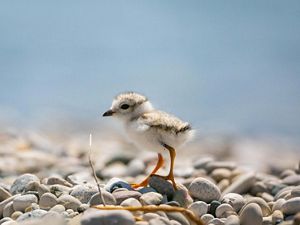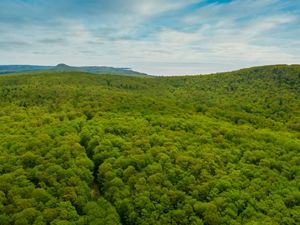U.P. High School Students Build Habitat to Help Hares
The Nature Conservancy, Michigan United Conservation Clubs, Lake Superior State University partner on unique, hands-on project
Media Contacts
-
Ryan Hermes
TNC
Phone: 517-999-7745
Email: ryan.hermes@tnc.org
In late September, more than a dozen high school students from Brimley Area Schools who participate in Lake Superior State University’s Career and Technical Education (CTE) program spent a crisp fall morning at The Nature Conservancy’s Two-Hearted River Forest Reserve building habitats and installing trail cameras. The habitats will serve as homes for rabbits and other small animals seeking shelter for the winter. The trail cameras will allow students to monitor their shelters over the next year.
The project is made possible through a partnership between The Nature Conservancy in Michigan (TNC), whose staff helped students build the habitats, Lake Superior State University (LSSU) and the Michigan United Conservation Clubs’ (MUCC) On the Ground program.
“I want to thank The Nature Conservancy and Michigan United Conservation Clubs for putting together such a fun project so our students could get hands-on experience in building wildlife habitats,” said Kirsten Hindy, CTE instructor and outreach and education specialist at the Center for Freshwater Research and Education at Lake Superior State University. “The Career and Technical Education program at Brimley Area Schools and Lake Superior State University provides students with a one-of-a-kind experience in the outdoors, and this project is just another example of how students can gain unique skills in nature.”
In total, six habitats were constructed across two acres on the reserve. Trail cameras were mounted to monitor each habitat. The trail cams will be maintained for the next year by TNC staff in the Upper Peninsula.
“The goal of On the Ground is to bring together individuals and groups of all ages and levels of outdoor experience to improve wildlife habitats, whether that means building habitats or planting trees,” said Kristina Kennedy, habitat program and partnerships coordinator for MUCC’s On the Ground program. “It was heartwarming to see how eager these high school students were to get their hands dirty and build something so meaningful for Michigan’s wildlife.”
“I couldn't think of a better way to spend a fall morning than working with these young conservationists to build wildlife habitats and make a positive impact on the reserve,” said Nicholas Mead, restoration association for TNC in Michigan. “These students are very passionate about the world around them and enthusiastically helped create a natural, productive, and crucial pieces of habitat. Their enthusiasm and positivity give me great hope for the future.”
The Nature Conservancy is a global conservation organization dedicated to conserving the lands and waters on which all life depends. Guided by science, we create innovative, on-the-ground solutions to our world’s toughest challenges so that nature and people can thrive together. We are tackling climate change, conserving lands, waters and oceans at an unprecedented scale, providing food and water sustainably and helping make cities more sustainable. The Nature Conservancy is working to make a lasting difference around the world in 81 countries and territories (40 by direct conservation impact and 41 through partners) through a collaborative approach that engages local communities, governments, the private sector, and other partners. To learn more, visit nature.org or follow @nature_press on X.



